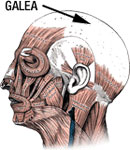Dear Dr. Rassman,
The question is in regards to the galeotomy procedure – originally pioneered by Dr. Lars Engstrand out of Sweden – I believe. The procedure was also popularized by the late prolific health writer Paavo Airola in his many writings.
I find this sunbject very interesting and have noticed an increasing interest for this procedure on the hair-loss forums, but very little information exists. I have heard that this procedure is quite effective and yet it seems to be totally ignored (or suppressed) in this country. What do you know about this procedure? Do you think it works? Do you have any first hand experience with anyone who has had it done? Do you, or can you, perform it? Does anyone in the U.S. perform it?
Please take the time to share what you know about this interesting topic.
 The galeatomy has been around for years. For those of you who do not know, above the skull lies the periosteum (the living membrane above the bone) and then the galea. Above the galea lies the scalp, which is very mobile (try to move your scalp around and you will see just how mobile it is). The scalp has a clear blood supply coming from the front, sides, and back of your head. The blood supply lies above the galea, so cutting the galea makes no sense. It is not easy to get to the galea unless you cut open the scalp. We have done galeatomies years ago with scalp reductions and today’s hairline lowering procedures, and brow lifts will frequently dissect the galea as part of the mobilization of the scalp. As working below the galea is relatively bloodless, it is a terrific surgical plane to work in. Cutting the galea will not increase the blood supply to the scalp, but will just produce morbidity if it is done in isolation of some good surgical reason to do it.
The galeatomy has been around for years. For those of you who do not know, above the skull lies the periosteum (the living membrane above the bone) and then the galea. Above the galea lies the scalp, which is very mobile (try to move your scalp around and you will see just how mobile it is). The scalp has a clear blood supply coming from the front, sides, and back of your head. The blood supply lies above the galea, so cutting the galea makes no sense. It is not easy to get to the galea unless you cut open the scalp. We have done galeatomies years ago with scalp reductions and today’s hairline lowering procedures, and brow lifts will frequently dissect the galea as part of the mobilization of the scalp. As working below the galea is relatively bloodless, it is a terrific surgical plane to work in. Cutting the galea will not increase the blood supply to the scalp, but will just produce morbidity if it is done in isolation of some good surgical reason to do it.
Competent doctors do not do perform this barbaric procedure for the treatment of hair loss.
Tags: galeatomy, galea, scalp, hairloss, hair loss, surgery

 The galeatomy has been around for years. For those of you who do not know, above the skull lies the periosteum (the living membrane above the bone) and then the galea. Above the galea lies the scalp, which is very mobile (try to move your scalp around and you will see just how mobile it is). The scalp has a clear blood supply coming from the front, sides, and back of your head. The blood supply lies above the galea, so cutting the galea makes no sense. It is not easy to get to the galea unless you cut open the scalp. We have done galeatomies years ago with scalp reductions and today’s hairline lowering procedures, and brow lifts will frequently dissect the galea as part of the mobilization of the scalp. As working below the galea is relatively bloodless, it is a terrific surgical plane to work in. Cutting the galea will not increase the blood supply to the scalp, but will just produce morbidity if it is done in isolation of some good surgical reason to do it.
The galeatomy has been around for years. For those of you who do not know, above the skull lies the periosteum (the living membrane above the bone) and then the galea. Above the galea lies the scalp, which is very mobile (try to move your scalp around and you will see just how mobile it is). The scalp has a clear blood supply coming from the front, sides, and back of your head. The blood supply lies above the galea, so cutting the galea makes no sense. It is not easy to get to the galea unless you cut open the scalp. We have done galeatomies years ago with scalp reductions and today’s hairline lowering procedures, and brow lifts will frequently dissect the galea as part of the mobilization of the scalp. As working below the galea is relatively bloodless, it is a terrific surgical plane to work in. Cutting the galea will not increase the blood supply to the scalp, but will just produce morbidity if it is done in isolation of some good surgical reason to do it. We use animal hair for wigs all of the time. Let’s say hypothetically that it is possible to use animal hair for transplants — which animal did you have in mind? If you picked the animal of your choice, what do you think PETA (People for the Ethical Treatment of Animals) would say? Hair transplant isn’t life or death, like a liver or heart. If PETA supports your cause (or you don’t care about what they think anyway), what doctor will you go to? A veterinarian? If a doctor is willing to do the surgery, what do you think your friends will say? It gives a whole new meaning to “sexy beast” …
We use animal hair for wigs all of the time. Let’s say hypothetically that it is possible to use animal hair for transplants — which animal did you have in mind? If you picked the animal of your choice, what do you think PETA (People for the Ethical Treatment of Animals) would say? Hair transplant isn’t life or death, like a liver or heart. If PETA supports your cause (or you don’t care about what they think anyway), what doctor will you go to? A veterinarian? If a doctor is willing to do the surgery, what do you think your friends will say? It gives a whole new meaning to “sexy beast” … The follicular unit extraction (FUE) procedure is in a way a mini-punch graft involving just one follicular unit. Instead of using 6mm punches, we use 0.9mm punches.
The follicular unit extraction (FUE) procedure is in a way a mini-punch graft involving just one follicular unit. Instead of using 6mm punches, we use 0.9mm punches.  Your case is complex. I have no idea what densities you have or the extent of your scar and wound defect. Most people who’ve had 7 scalp reductions are left with a slot deformity. I would like to see some good pictures of your scalp from the front, top, sides, and back. I am sure that you know that scalp reduction is no longer the standard of care today, because they do not work. I have seen men who had up to 16 scalp reduction surgeries and the last ones never really accomplished anything. I wonder about your 7th procedure and what you were trying to accomplish that the prior 6 have not.
Your case is complex. I have no idea what densities you have or the extent of your scar and wound defect. Most people who’ve had 7 scalp reductions are left with a slot deformity. I would like to see some good pictures of your scalp from the front, top, sides, and back. I am sure that you know that scalp reduction is no longer the standard of care today, because they do not work. I have seen men who had up to 16 scalp reduction surgeries and the last ones never really accomplished anything. I wonder about your 7th procedure and what you were trying to accomplish that the prior 6 have not.